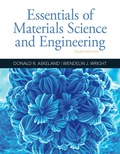
Interpretation:
The surface concentration of
Concept introduction:
The Fick's second law is used to determine the amount of phosphorus and boron at any depth
The expression for the Fick's second law is as follows:
After derivation:
Here,
Answer to Problem 5.56P
Surface concentration for
Surface concentration for
Explanation of Solution
For the n type region:
Here, the constant concentration of diffusing atoms at the surface is
The uniform concentration of diffusing atoms in the material
The concentration of diffusing atoms at location
Time
The diffusion coefficient
Substitute the above values in Fick's equation
Find the value of
| Error function values for Fick's second law | |
| Argument of the error
| Values of the error function
|
|
| |
| | |
| | |
| | |
| | |
| | |
| | |
| | |
| | |
| | |
| | |
| | |
| | |
Hence, Surface concentration for
For the
Here, the constant concentration of diffusing atoms at the surface is
The uniform concentration of diffusing atoms in the material
The concentration of diffusing atoms at location
Time
The diffusion coefficient
Substitute the above value in equation
Find the value of
Hence, surface concentration for
The value of surface concentration for both
Thus, the surface concentration for
Surface concentration for
Want to see more full solutions like this?
Chapter 5 Solutions
Essentials Of Materials Science And Engineering
- Given the following addresses, which two addresses conflict in the cache: The numb of locations in the cache is 2048, the cahche is indexed by address bits 15 to 5 and the tag bits are from 31 to 16. (a) 0x0000 0100 (b) 0x0000 1400 (c) 0x0010 0100 (d) 0x0100 0140arrow_forwardWrite a love poem about someone longing for a sandwich. Make it sonnet,and give it a tone that straddles a serious love poem and whimsy appropriate for a poem about a sandwich.arrow_forwardpower systems engineeringarrow_forward
- power systemsarrow_forward2. Consider the following pseudocode for partition: function partition (A,L,R) pivotkey = A [R] t = L for i L to R-1 inclusive: if A[i] A[i] t = t + 1 end if end for A [t] A[R] return t end function Suppose we call partition (A,0,5) on A=[10,1,9,2,8,5]. Show the state of the list at the indicated instances. Initial A After i=0 ends After 1 ends After i 2 ends After i = 3 ends After i = 4 ends After final swap 10 19 285 [12 pts]arrow_forwardDraw as a 3D object/Isometricarrow_forward
- power systemsarrow_forward.NET Interactive Solving Sudoku using Grover's Algorithm We will now solve a simple problem using Grover's algorithm, for which we do not necessarily know the solution beforehand. Our problem is a 2x2 binary sudoku, which in our case has two simple rules: •No column may contain the same value twice •No row may contain the same value twice If we assign each square in our sudoku to a variable like so: 1 V V₁ V3 V2 we want our circuit to output a solution to this sudoku. Note that, while this approach of using Grover's algorithm to solve this problem is not practical (you can probably find the solution in your head!), the purpose of this example is to demonstrate the conversion of classical decision problems into oracles for Grover's algorithm. Turning the Problem into a Circuit We want to create an oracle that will help us solve this problem, and we will start by creating a circuit that identifies a correct solution, we simply need to create a classical function on a quantum circuit that…arrow_forwardpower systemsarrow_forward
- Post-tensioned AASHTO Type II girders are to be used to support a deck with unsupported span equal to 10 meters. Two levels of Grade 250, 10 x 15.2 mm Ø 7-wire strand are used to tension the girders with 5 tendons per level, where the tendons on top stressed before the ones on the bottom. The girder is simply supported at both ends. The anchors are located 100 mm above the neutral axis at the supports while the eccentricity is measured at 400 mm at the midspan. The tendon profile follows a parabolic shape using a rigid metal sheathing. A concrete topping (slab) 130 mm thick is placed above the beam with a total tributary width of 4 meters. Use maximum values for ranges (table values). Assume that the critical section of the beam is at 0.45LDetermine the losses (friction loss, anchorage, elastic shortening, creep, shrinkage, relaxation). Determine the stresses at the top fibers @ critical section before placing a concrete topping, right after stress transfer. Determine the stress at the…arrow_forwardpower systemsarrow_forwardpower system engineeringarrow_forward
 MATLAB: An Introduction with ApplicationsEngineeringISBN:9781119256830Author:Amos GilatPublisher:John Wiley & Sons Inc
MATLAB: An Introduction with ApplicationsEngineeringISBN:9781119256830Author:Amos GilatPublisher:John Wiley & Sons Inc Essentials Of Materials Science And EngineeringEngineeringISBN:9781337385497Author:WRIGHT, Wendelin J.Publisher:Cengage,
Essentials Of Materials Science And EngineeringEngineeringISBN:9781337385497Author:WRIGHT, Wendelin J.Publisher:Cengage, Industrial Motor ControlEngineeringISBN:9781133691808Author:Stephen HermanPublisher:Cengage Learning
Industrial Motor ControlEngineeringISBN:9781133691808Author:Stephen HermanPublisher:Cengage Learning Basics Of Engineering EconomyEngineeringISBN:9780073376356Author:Leland Blank, Anthony TarquinPublisher:MCGRAW-HILL HIGHER EDUCATION
Basics Of Engineering EconomyEngineeringISBN:9780073376356Author:Leland Blank, Anthony TarquinPublisher:MCGRAW-HILL HIGHER EDUCATION Structural Steel Design (6th Edition)EngineeringISBN:9780134589657Author:Jack C. McCormac, Stephen F. CsernakPublisher:PEARSON
Structural Steel Design (6th Edition)EngineeringISBN:9780134589657Author:Jack C. McCormac, Stephen F. CsernakPublisher:PEARSON Fundamentals of Materials Science and Engineering...EngineeringISBN:9781119175483Author:William D. Callister Jr., David G. RethwischPublisher:WILEY
Fundamentals of Materials Science and Engineering...EngineeringISBN:9781119175483Author:William D. Callister Jr., David G. RethwischPublisher:WILEY





